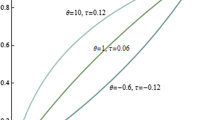Abstract
A lot of progress regarding estimation of nested Archimedean copulas has been booked since their introduction by Joe (Multivariate models and dependence concepts. Chapman and Hall, London, 1997). The currently published procedures can be seen as particular cases of two different, more general, approaches. In the first approach, the tree structure of the target nested Archimedean copulas is estimated using hierarchical clustering to get a binary tree, and then parts of this binary tree are collapsed according to some strategy. This two-step estimation of the tree structure paves the way for estimation of the generators according to the sufficient nesting condition afterwards, this sufficient nesting condition on the generators ensuring the resulting estimated nested Archimedean copula is a proper copula. In contrast to the first approach, the second approach estimates the tree structure free of any concern for the generators. While this is the main strength of this second approach, it is also its main weakness: estimation of the generators afterwards so that the resulting nested Archimedean copula is a proper copula still lacks a solution. In this paper, both approaches are formally explored, detailed explanations and examples are given, as well as results from a performance study where a new way of comparing tree structure estimators is offered. A nested Archimedean copula is also estimated based on exams results from 482 students, and a naive attempt to check the fit is made using principal component analysis.














Similar content being viewed by others
Notes
This correction has already been implemented in Okhrin’s R package HAC.
References
Alfons A, Croux C, Filzmoser P (2017) Robust maximum association estimators. J Am Stat Assoc 112(517):436–445. doi:10.1080/01621459.2016.1148609
Bininda-Emonds OR (2004) The evolution of supertrees. Trends Ecol Evol 19(6):315–322
Felsenstein J (2004) Inferring phylogenies. Sinauer Associates, Sunderland
Górecki J, Hofert M, Holeňa M (2014) On the consistency of an estimator for hierarchical Archimedean copulas. In: 32nd international conference on mathematical methods in economics, pp 239–244
Górecki J, Hofert M, Holeňa M (2015) An approach to structure determination and estimation of hierarchical Archimedean copulas and its application to Bayesian classification. J Intell Inf Syst 46:1–39
Hess PN, De Moraes Russo CA (2007) An empirical test of the midpoint rooting method. Biol J Linn Soc 92(4):669–674
Hoeffding W (1948) A non-parametric test of independence. Ann Math Stat 19:546–557
Hofert M (2011) Efficiently sampling nested Archimedean copulas. Comput Stat Data Anal 55(1):57–70
Hofert M, Maechler M (2011) Nested Archimedean copulas meet R: The nacopula package. J Stat Softw 39(9):1–20
Hofert M, Pham D (2013) Densities of nested Archimedean copulas. J Multivar Anal 118:37–52
Holeňa M, Bajer L, Ščavnickỳ M (2015) Using copulas in data mining based on the observational calculus. IEEE Trans Knowl Data Eng 27(10):2851–2864
Joe H (1997) Multivariate models and dependence concepts. Chapman and Hall, London
McNeil AJ (2008) Sampling nested Archimedean copulas. J Stat Comput Simul 78(6):567–581
McNeil AJ, Nešlehová J (2009) Multivariate Archimedean copulas, \(d\)-monotone functions and \(l_1\)-norm symmetric distributions. Ann Stat 37:3059–3097
Ng MP, Wormald NC (1996) Reconstruction of rooted trees from subtrees. Discret Appl Math 69(1):19–31
Nixon KC (1999) The parsimony ratchet, a new method for rapid parsimony analysis. Cladistics 15(4):407–414
Okhrin O, Ristig A (2014) Hierarchical Archimedean copulae: the HAC package. J Stat Softw 58:1–20
Okhrin O, Okhrin Y, Schmid W (2013a) On the structure and estimation of hierarchical Archimedean copulas. J Econom 173(2):189–204
Okhrin O, Okhrin Y, Schmid W (2013b) Properties of hierarchical Archimedean copulas. Stat Risk Model 30(1):21–54
Okhrin O, Ristig A, Sheen J, Trück S (2015) Conditional systemic risk with penalized copula. Technical report, Sonderforschungsbereich 649, Humboldt University, Berlin, Germany
Revell LJ (2012) phytools: an R package for phylogenetic comparative biology (and other things). Methods Ecol Evol 3:217–223
Rezapour M (2015) On the construction of nested Archimedean copulas for d-monotone generators. Stat Probab Lett 101:21–32
Saitou N, Nei M (1987) The neighbor-joining method: a new method for reconstructing phylogenetic trees. Mol Biol Evol 4(4):406–425
Segers J, Uyttendaele N (2014) Nonparametric estimation of the tree structure of a nested Archimedean copula. Comput Stat Data Anal 72:190–204
Swenson MS, Suri R, Linder CR, Warnow T (2012) Superfine: fast and accurate supertree estimation. Syst Biol 61(2):214–227
Tarrio R, Rodriguez-Trelles F, Ayala FJ (2000) Tree rooting with outgroups when they differ in their nucleotide composition from the ingroup: the Drosophila saltans and willistoni groups, a case study. Mol Phylogenet Evol 16(3):344–349
Wheeler WC (1990) Nucleic acid sequence phylogeny and random outgroups. Cladistics 6(4):363–367
Wilkinson M, Cotton JA, Creevey C, Eulenstein O, Harris SR, Lapointe F-J, Levasseur C, Mcinerney JO, Pisani D, Thorley JL (2005) The shape of supertrees to come: tree shape related properties of fourteen supertree methods. Syst Biol 54(3):419–431
Acknowledgements
Special thanks to Liam Revell who helped me a great deal regarding the world of phylogenetics to which I wasn’t accustomed prior to this research. I would also like to thank Johan Segers for his constructive comments regarding this research.
Author information
Authors and Affiliations
Corresponding author
Rights and permissions
About this article
Cite this article
Uyttendaele, N. On the estimation of nested Archimedean copulas: a theoretical and an experimental comparison. Comput Stat 33, 1047–1070 (2018). https://doi.org/10.1007/s00180-017-0743-1
Received:
Accepted:
Published:
Issue Date:
DOI: https://doi.org/10.1007/s00180-017-0743-1




